The Intel Optane Memory (SSD) Preview: 32GB of Kaby Lake Caching
by Billy Tallis on April 24, 2017 12:00 PM EST- Posted in
- SSDs
- Storage
- Intel
- PCIe SSD
- SSD Caching
- M.2
- NVMe
- 3D XPoint
- Optane
- Optane Memory
BAPCo SYSmark 2014 SE
BAPCo's SYSmark 2014 SE is an application-based benchmark that uses real-world applications to replay usage patterns of business users in the areas of office productivity, media creation and data/financial analysis. In addition, it also addresses the responsiveness aspect which deals with user experience as related to application and file launches, multi-tasking etc. Scores are meant to be compared against a reference desktop (the SYSmark 2014 SE calibration system in the graphs below). While the SYSmark 2014 benchmark used a Haswell-based desktop configuration, the SYSmark 2014 SE makes the move to a Lenovo ThinkCenter M800 (Intel Core i3-6100, 4GB RAM and a 256GB SATA SSD). The calibration system scores 1000 in each of the scenarios. A score of, say, 2000, would imply that the system under test is twice as fast as the reference system.
SYSmark scores are based on total application response time as seen by the user, including not only storage latency but time spent by the processor. This means there's a limit to how much a storage improvement could possibly increase scores. It also means our Optane review system starts out with an advantage over the SYSmark calibration system due to the faster processor and more RAM.



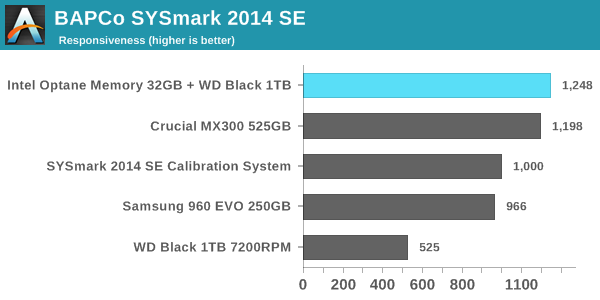
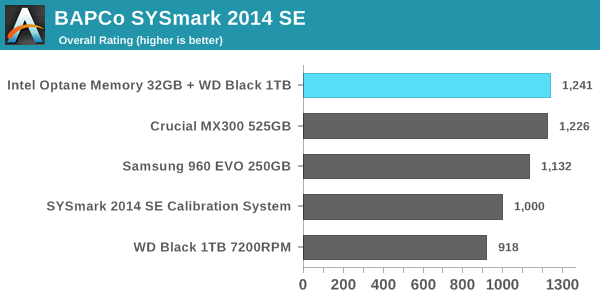
In every performance category the Optane caching setup is either in first place or a close tie for first. The Crucial MX300 is tied with the Optane configuration for every sub-test except the responsiveness test, where it falls slightly behind. The Samsung 960 EVO 250GB struggles, partly because its low capacity and the low degree of parallelism that implies means it often cannot take advantage of the performance offered by its PCIe 3.0 x4 interface. The use of Microsoft's built-in NVMe driver instead of Samsung's may also be holding it back. As expected, the WD Black hard drive scores substantially worse than our solid-state configurations on every test, with the biggest disparity occurring in the responsiveness test: The WD Black hard drive will force users to spend more than twice as much time waiting on their computer than if it has a SSD.
Energy Usage
SYSmark 2014 SE also adds energy measurement to the mix. A high score in the SYSmark benchmarks might be nice to have, but, potential customers also need to determine the balance between power consumption and the efficiency of the system. For example, in the average office scenario, it might not be worth purchasing a noisy and power-hungry PC just because it ends up with a 2000 score in the SYSmark 2014 SE benchmarks. In order to provide a balanced perspective, SYSmark 2014 SE also allows vendors and decision makers to track the energy consumption during each workload. In the graphs below, we find the total energy consumed by the PC under test for a single iteration of each SYSmark 2014 SE workload and how it compares against the calibration systems.
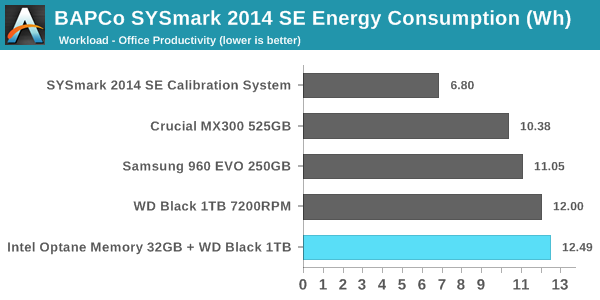
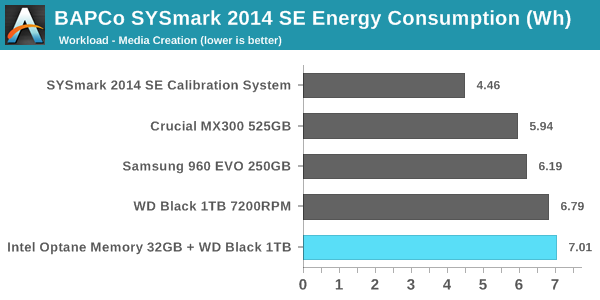
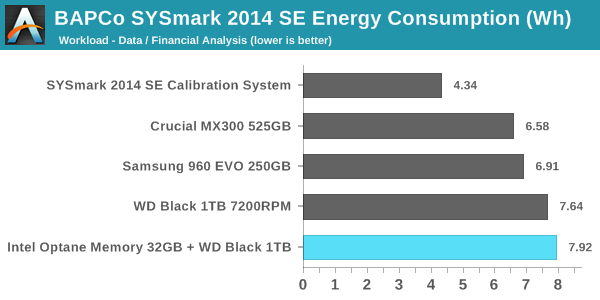
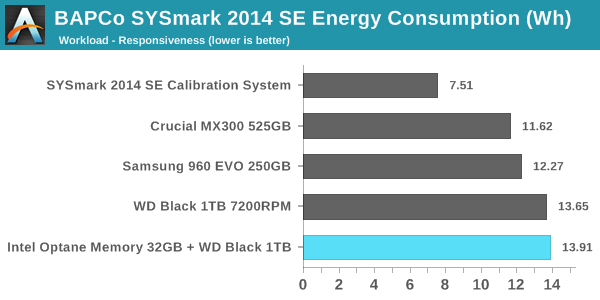
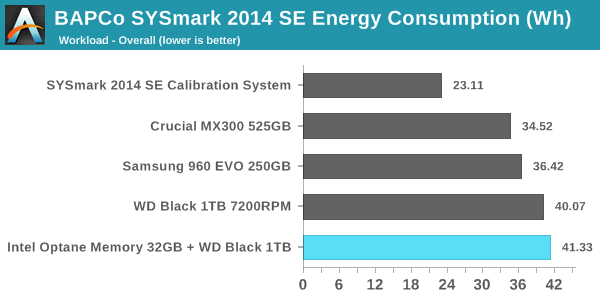
The peak power consumption of a PCIe SSD under load can exceed the power draw of a hard drive, but over the course of a fixed workload hard drives will always be less power efficient. SSDs almost always complete the data transfer sooner, and they can enter and leave their low-power idle states far quicker. On a benchmark like SYSmark, there are no idle times long enough for a hard drive to spin down and save power.
With an idle power of 1W, the Optane cache module substantially increases the already high power consumption of the hard drive-based configurations. It does allow for the tests to complete sooner, but since the Optane module does nothing to accelerate the compute-bound portions of SYSmark, the total time saved is not enough to make up the difference. It also appears that the Optane caching is not being used to enable more aggressive power saving on the hard drive—Intel's probably flushing writes from the cache often enough to keep the hard drive spinning the whole time. What this adds up to is a difference that's quite clear but not big enough for desktop users to be too concerned with unless their electricity prices are high. The Optane Memory caching configuration is the most power-hungry option we tested, while the second-place performing Crucial MX300 configuration was most efficient, using about 16% less energy overall.
For mobile users, the power consumption of the Optane plus hard drive configuration is pretty much a deal-breaker. Our Optane review system is not optimized for power consumption the way a notebook system would be, so for a mobile user the Optane module would account for an even larger portion of the total battery draw, and battery life will take a serious hit.










110 Comments
View All Comments
evilpaul666 - Thursday, April 27, 2017 - link
Everyone presumes that technology will improve over time. Talking up 1000x improvements, making people wait for a year or more, and then releasing a stupid expensive small drive for the Enterprise segment, and a not particularly useful tiny drive for whoever is running a Core i3 7000 series or better CPU with a mechanical hard drive, for some reason, is slightly disappointing.We wanted better stuff now after a year of waiting not at some point in the future which was where we've always been.
Lehti - Tuesday, April 25, 2017 - link
Hmm... And how does this compare to regular SSD caching using Smart Response? So far I can't see why anyone would want an Optane cache as opposed to that or, even better, a boot SSD paired with a storage hard drive.Calin - Tuesday, April 25, 2017 - link
Did you brought the WD Caviar to steady state by filling it twice with random data in random files? Performance of magnetic media varies greatly based on drive fragmentationBilly Tallis - Wednesday, April 26, 2017 - link
I didn't pre-condition any of the drives for SYSmark, just for the synthetic tests (which the hard drive wasn't included in). For the SYSmark test runs, the drives were all secure erased then imaged with Windows.MrSpadge - Tuesday, April 25, 2017 - link
"Queue Depth > 1When testing sequential writes at varying queue depths, the Intel SSD DC P3700's performance was highly erratic. We did not have sufficient time to determine what was going wrong, so its results have been excluded from the graphs and analysis below."
Yes, the DC P3700 is definitely excluded from these graphs.. and the other ones ;)
Billy Tallis - Wednesday, April 26, 2017 - link
Oops. I copied a little too much from the P4800X review...MrSpadge - Tuesday, April 25, 2017 - link
Billy, why is the 960 Evo performing so badly under Sysmark 2014, when it wins almost all synthetic benchmarks against the MX300? Sure, it's got fewer dies.. but that applies to the low level measurements as well.Billy Tallis - Wednesday, April 26, 2017 - link
I don't know for sure yet. I'll be re-doing the SYSmark tests with a fresh install of Windows 10 Creators Update, and I'll experiment with NVMe drivers and settings. My suspicion is that the 960 EVO was being held back by Microsoft's horrific NVMe driver default behavior, while the synthetic tests in this review were run on Linux.MrSpadge - Wednesday, April 26, 2017 - link
That makes sense, thanks for answering!Valantar - Tuesday, April 25, 2017 - link
Is there any reason why one couldn't stick this in any old NVMe-compatible motherboard regardless of paltform and use a software caching system like PrimoCache on it? It identifies to the system as a standard NVMe drive, no? Or does it somehow have the system identify itself on POST and refuse to communicate if it provides the "wrong" identifier?